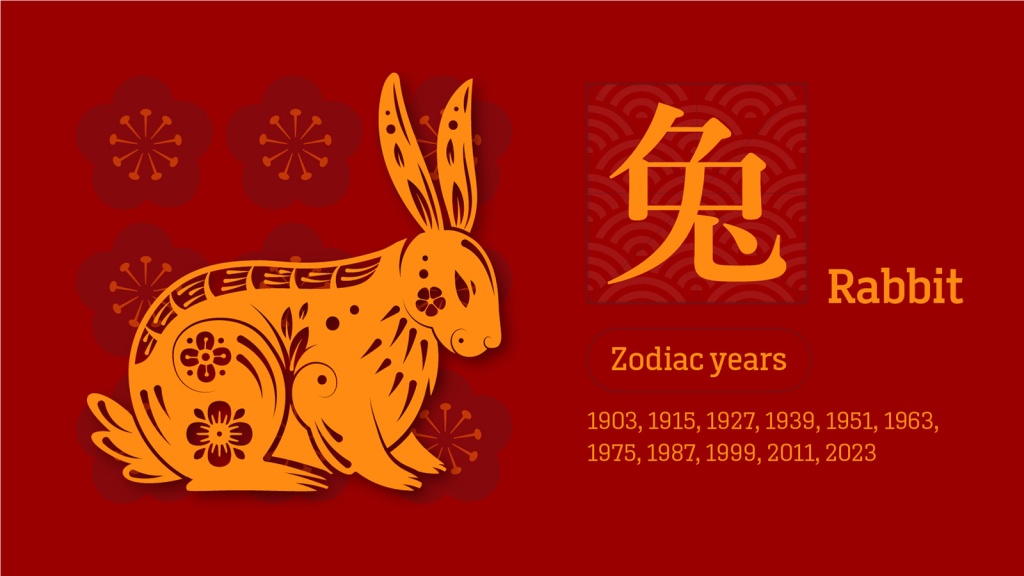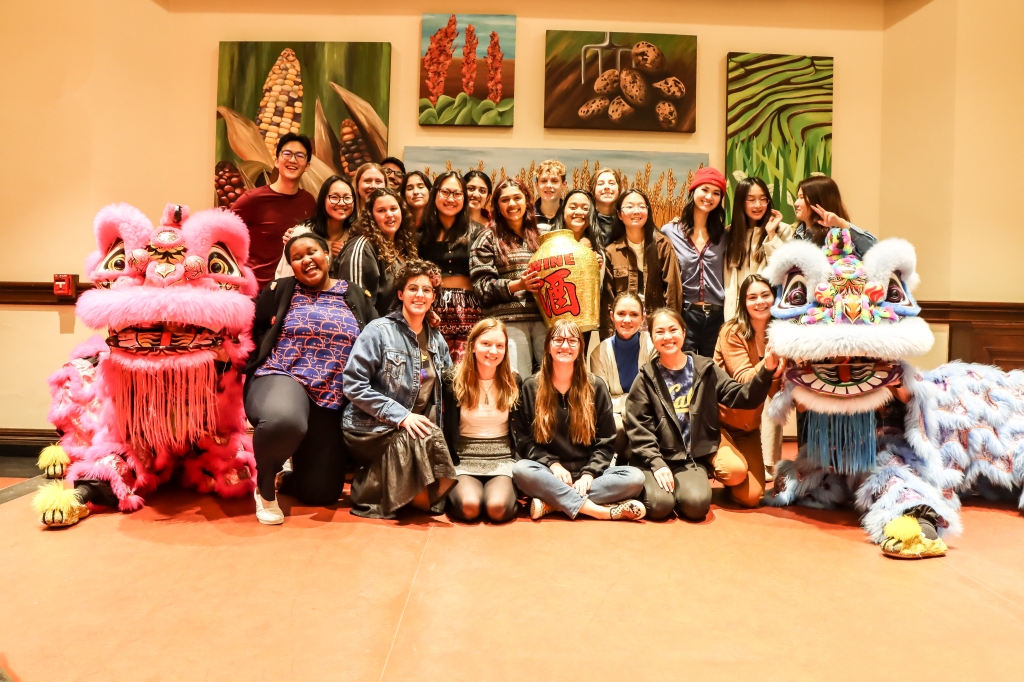I was curious to experience the Lunar New Year at I-House. So, I have spent the week preceding the Lunar New Year, anticipating, researching, and reading about it. I learned that it was the year of Rabbit. How cute!

The Lunar New Year week was colorful. Colorful in the sense that the Dining Commons and some parts of I-House were decorated with beautiful ribbons and paintings. Anyone visiting I-House would notice the decorations and atmosphere of celebrations. Predominant were the colors, red and yellow.




A variety of Asian dishes were prepared by Chef Abbie and her team: Crab Rangoon; Vegetarian Cream Cheese Rangoon; Vegetable Potstickers and Spring rolls; Vegan Buddha’s Delight with Tofu; Vegetable Fried Rice; Cod with Ginger Soy Scallion Sauce; Shrimp in Lobster Sauce; Crispy Five Spice Chicken; Curry Rice Noodles; Chow Mein; and Sauteed Garlic Gailan. It was a delicious feast!
There were a lot of sweets and fortune cookies too. In each cookie, there is a quote, prayer, or blessing. Some of the residents told me that the fortune cookie is an Asian-American thing and it wasn’t done back in their countries.

While having dinner on Lunar New Year’s Day, I noticed the traditional dress worn by some residents. The spectacular dancing troupe captivated everyone with their performance. The celebration continued through early evening.

Photos above were captured by resident Bhawna Chowdhary, Social Media Ambassador.
Below are a few photos that I captured.




Resident Interviews
I’m grateful I was able to experience this festive event at International House! More importantly, I was able to interview four residents who celebrate Lunar New Year.
JOUNG (KALISTA) JAEWON (SOUTH KOREA)

My first contact was Joung Jaewon (Kalista) from South Korea.
Kalista: We celebrate Lunar New Year in my home country, South Korea. We do celebrate both Lunar New Year and the New Year (January 1st) but Lunar New Year is valued more traditionally as it has been a celebration where all family members gather together and catch up.
Oke: How do you celebrate it? What customs and traditions?
Kalista: We usually celebrate it with our family members. Family gatherings, spending time together, catching up with one another, cooking traditional food together, and wishing the best of luck for the upcoming year with each other. Some families play games or wear traditional clothes as well – called Hanbok.
Oke: What food is typical of this celebration in your culture?
Kalista: We usually eat a rice cake soup called “Tteokguk” on the first of January and/or Lunar New Year’s Day. It is a clear broth soup topped with disc-shaped rice cakes which has a symbolic meaning of getting one year older.
Oke: What did you love about the I-House Lunar New Year event and dinner?
Kalista: Most of my best friends – who I want to keep as my lifetime friends – that I met at I-House are Taiwanese, Chinese, Singaporean, and Vietnamese. They mostly celebrate Lunar New Year in similar ways as I do in my home country. I love how they prepared Taiwanese Coffee Hour over the Lunar New Year week, and how everyone, regardless of where they are from, all cooked together in the kitchen to wish each other good luck for the upcoming year in I-House and their home nation.
SEUNGYUN LEE (SOUTH KOREA)

Then I spoke to Seungyun Lee, also from South Korea. Below is his response:
Oke: Do you celebrate Lunar New Year in your country/culture?
Seungyun: Yes, South Korea does celebrate Lunar New Year, also known as Seollal.
Oke: How do you celebrate it? What customs and traditions?
Seungyun: During Seollal, many South Koreans traditionally visit their family members and participate in various ancestral rituals. They also play traditional games, such as yutnori, and eat traditional foods.
Oke: What food is typical of this celebration in your culture?
Seungyun: Some traditional foods that are typically eaten during Seollal include tteokguk (a rice cake soup), jeon (a type of Korean pancake), and mandu (dumplings).
Oke: What did you love about the I-House Lunar New Year event and dinner?
Seungyun: I liked the Taiwanese Coffee Hour and the Lion dragon mask dance performance they showed in the dining commons.
YULAN WANG (JAPAN)

Yulan, a resident from Japan was the next person I contacted for the interview.
Yulan: We don’t celebrate Lunar New Year in Japan, but we do on January 1st, which is the largest and most important event in Japan.
Oke: How do you celebrate it? What customs and traditions?
Yulan: “Big” cleaning. We believe that if you clean every nook and cranny by dusting off, the New Year God will grant you many blessings. There are ornaments such as kadomatsu in front of the entrance, shimekazari at high locations such as entrance doors and pillars, and kagami-mochi in rooms. Then there is Hatsumoude, the first visit of the year to a shrine people make wishes for the coming year, drawing an omikuji (fortune slip). There is the New Year’s gift, Otoshidama, as children receive gifts of money from parents/relatives.
Oke: What food is typical of this celebration in your culture?
Yulan: – Toshikoshi soba, Osechi, Zoni and Nanakusa-gayu.
Osechi include “nimono,” vegetables simmered in sugar, soy sauce, and mirin (a time of rice wine used for cooking), as well as foods cured in salt or vinegar.
Zoni are the rice cakes, “mochi” are heated, then put into a bowl, poured over with the soup, and garnished. There are variations throughout Japan as to what they call “zoni”, but base ingredients typically include shrimp, gelatin, daikon radish, carrot, mochi, dashi and soy sauce.
Nanakasa-gayu: the seven-herb rice porridge which includes Java water dropwort, Shepherd‘s purse, Jersey cudweed, common chickweed, Japanese nipplewort, turnip, and daikon.
Oke: What did you love about the I-House Lunar New Year event and dinner?
Yulan: The ornaments in the dining hall and Chinese dishes allowed us to feel and know what the Lunar New Year celebration is like.
JOYCE CHEN (CHINA)

Joyce from China was the next in the interview.
Oke: Do you celebrate Lunar New Year in your country/culture?
Joyce: Yes! I grew up celebrating Lunar/Chinese New Year both in China and the Philippines. It’s the biggest festival in Chinese culture. In my family, we celebrate the New Year as a way to look fondly back at the past year and into the future.
Oke: How do you celebrate it?
Joyce: When my family was living in China, it’d be a huge family celebration, where we would gather with the rest of my extended family coming from all different places. My favorite parts were lighting the firework at night time – it’s always magical to see the effects light up the sky, and of course, receiving red pockets from relatives.
When we moved to the Philippines, we would gather with other families to usually make dumplings, or just share a big meal together. It was a way for us to be reminded of our roots and traditions.
Oke: What customs and traditions?
Joyce: Making dumplings, playing Mahjong, and getting Hongbao (red pockets) as kids!
In the Philippines, shopping malls would have dragon/lion dancers, which means to usher luck and prosperity, going shop to shop to collect “ampao” (Tagalog/Hokkien for red pockets). It’s quite a scene and I always marvel at the cool dragon dances.
Oke: What food is typical of this celebration in your culture?
Joyce: Dumplings, Niangao/Tikoy, spring rolls, and loads and loads of snacks and fruits.
Oke: What did you love about the I-House Lunar New Year event and dinner?
Joyce: I stayed in Manila to celebrate the Lunar New Year this year! But the decorations in the dining hall looked very festive.
Conclusion: In the end, I have learned and appreciated what it means to live in a multicultural environment. I am happy many residents showed up to watch the celebrants showcase their amazing culture through dance, food, dress, and beliefs. International House as I always say, will remain an education of its own.
Do you remember Lunar New Year celebrations at I-House or in your home country? Please share in the comments below.









